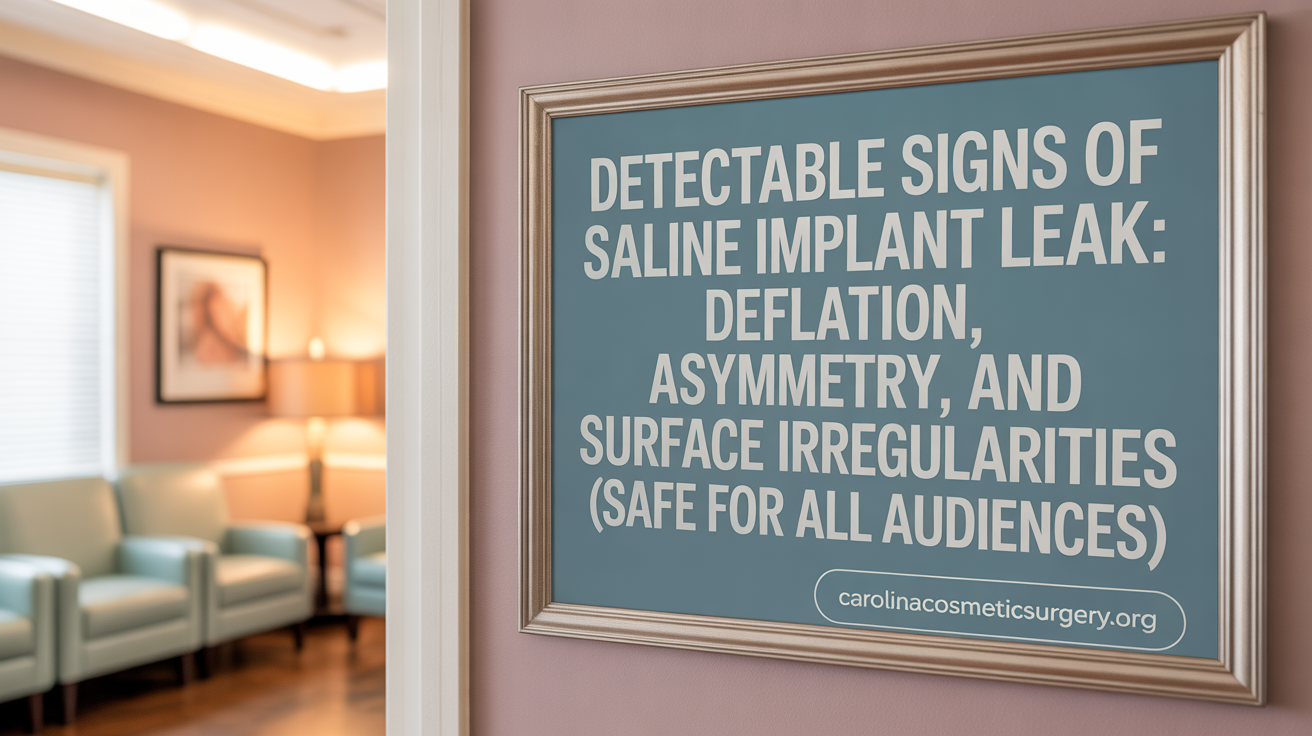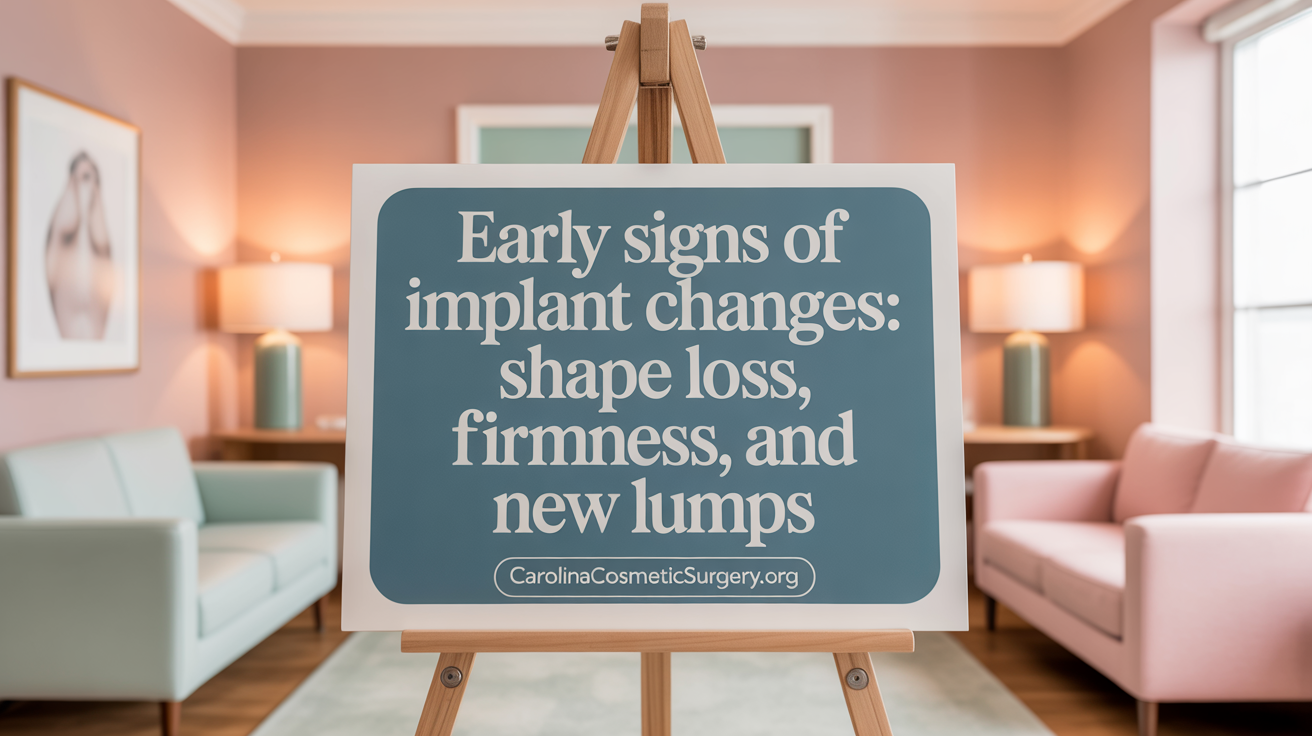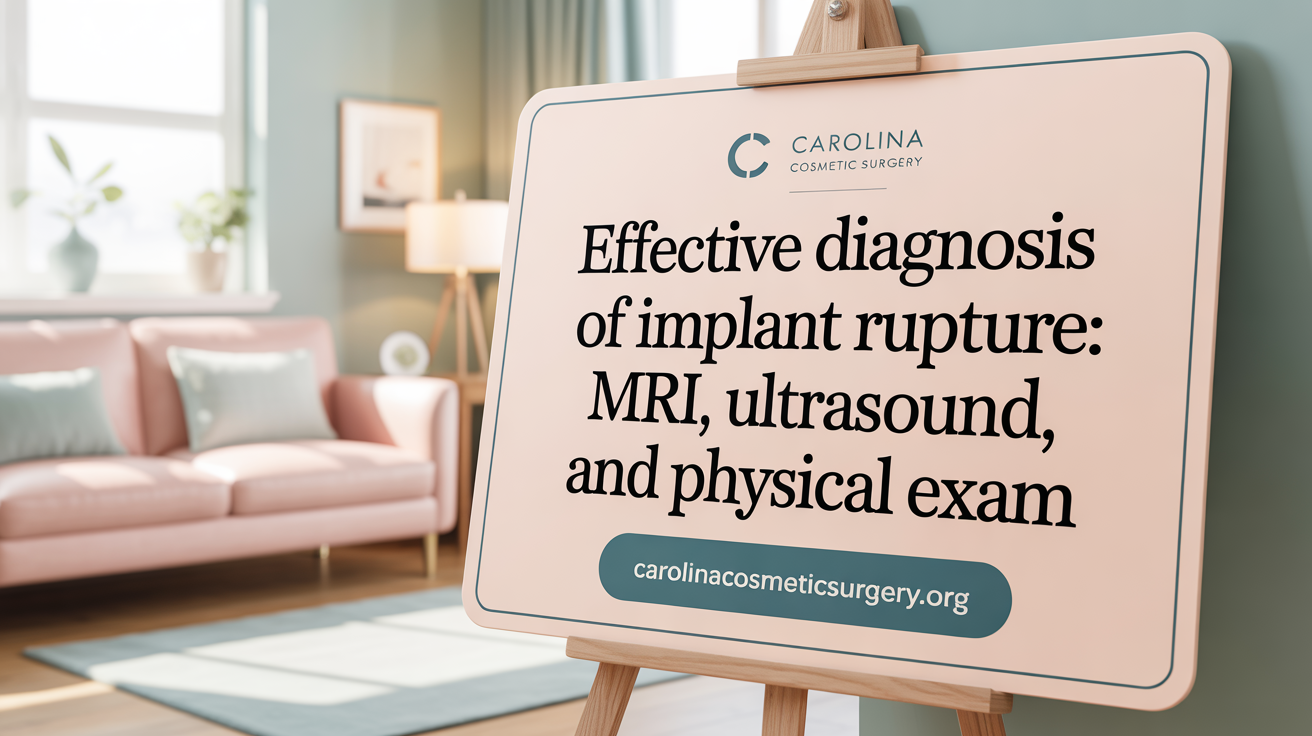Introduction to Breast Implant Integrity
Breast implants, whether saline or silicone, are designed to provide long-lasting aesthetic results. However, over time, implants may rupture or leak, which can affect their appearance and potentially pose health concerns. Recognizing the early signs and symptoms of implant rupture is crucial for prompt diagnosis and treatment. This article explores the physical indicators, diagnostic methods, and health implications associated with breast implant rupture or leakage, guiding readers on when and how to seek professional evaluation.
Common Signs and Symptoms of Breast Implant Rupture

What are common symptoms and signs of breast implant rupture or leakage?
Breast implant ruptures can present with different signs depending on whether the implant is filled with saline or silicone. Saline implant ruptures are usually immediately noticeable because the saline leaks out quickly, causing the breast to deflate. This results in a visibly flattened breast, asymmetry, and a change in size or shape. Patients might also notice rippling or indentation along the breast.
In contrast, silicone implant ruptures can be more subtle. Many silicone implant ruptures are 'silent,' meaning they do not cause obvious physical changes or symptoms initially. When symptoms do occur, they can include chest pain, tenderness, lumps, swelling, firmness, or a changed appearance of the breast. Some women experience increased sensitivity or numbness, and silicone gel might leak into surrounding tissues.
An important aspect of detecting ruptures is awareness of differences in presentation. With saline implants, deflation and immediate shape change are typical. Silicone ruptures, on the other hand, often require imaging procedures like MRI or ultrasound to diagnose. MRI scans are especially reliable, with the FDA recommending routine scans starting three years after surgery and every two years after that for silent rupture detection.
In cases where ruptures result in silicone gel migration outside the capsule, lumps or firmness can develop, sometimes leading to capsular contracture. Therefore, prompt diagnosis and surgical removal or replacement are advised to avoid further complications, with silicone ruptures needing especially swift intervention.
Recognizing Saline Breast Implant Leakage: Visual and Physical Changes

What symptoms are associated with a saline breast implant leak?
Signs of a saline implant rupture can be quite noticeable. Patients often see their affected breast deflate quickly, resulting in a significant change in size or shape. This sudden deflation can cause asymmetry, making one breast appear smaller or uneven compared to the other.
In addition to visual changes, physical symptoms such as tenderness or firmness in the breast may occur. The affected breast might feel softer or more squishy initially, or it can become tender to touch. Sometimes, ripples, indentations, or irregularities on the surface of the breast are visible.
Because saline leaks cause rapid implant deflation, these signs are generally immediately detectable through visual inspection or palpation. Women may notice a lopsided or flatter appearance, especially if the deflation occurs suddenly. This quick change often prompts urgent medical consultation.
Prompt removal and evaluation are recommended if a leak is suspected, to prevent further complications and to restore breast shape. Early detection allows for easier surgical correction and peace of mind.
Symptoms and Challenges of Detecting Silicone Implant Rupture

What are the specific symptoms of silicone breast implant rupture?
The symptoms of silicone breast implant rupture vary, with many cases being silent, meaning they do not show obvious signs initially. When symptoms do occur, they often include breast pain or tenderness, which can range from mild discomfort to persistent pain. Changes in breast shape and size are common, such as unevenness or contour irregularities. Patients might also notice lumps, hardness, or thickening around the implant area. Swelling and redness can occur if there is an inflammatory response.
Unlike saline implants, which deflate quickly and cause immediate visible changes, silicone implant ruptures often develop gradually. This slow progression makes early detection challenging because many women are unaware of any issues.
Particularly with silent ruptures, no external signs are apparent. These ruptures are only detectable through imaging studies like MRI or ultrasound, as they do not cause noticeable deformation or deflation of the breast.
In addition to localized symptoms, some women experience systemic symptoms such as fatigue, joint pain, and changes in sensation, which are linked to breast implant illness (BII). These systemic symptoms can sometimes prompt further testing to evaluate implant integrity.
Given that most silicone implant ruptures are asymptomatic initially, routine MRI screenings are strongly recommended. The FDA advises women to undergo MRI scans starting three years after implant surgery and every two years thereafter for early detection, preventing potential complications like capsular contracture or silicone migration.
Early Warning Signs and Visual Changes Indicating Implant Damage

What are the early warning signs of breast implant damage or rupture?
Detecting implant damage early can significantly improve outcomes and simplify treatment. Common initial signs include noticeable changes in breast shape and size. For example, a saline implant rupture typically causes the breast to deflate quickly, resulting in flattening, asymmetry, or a visibly deflated appearance.
Additionally, patients might notice lumps, bumps, or irregularities that suggest rupture or capsular contracture—a condition where scar tissue tightens around the implant, causing hardness or distortion. Pain or tenderness in the breast area is another important symptom, especially if it occurs suddenly or worsens over time.
In the case of silicone implants, ruptures often remain silent initially, without obvious physical changes. These silent ruptures can be detected only through imaging techniques like MRI or ultrasound. Symptoms that might suggest a silicone rupture include swelling, breast firmness, painful lumps, or shape changes that develop gradually.
Other signs include skin redness, hardness, a feeling of tightness, or changes in sensation such as tingling, numbness, or burning. If the implant shifts from its original position, causing asymmetry or unusual contours, these could also be indications of rupture or displacement.
Prompt medical consultation is crucial if any of these signs are observed, especially if there is concern over a rupture. Early evaluation helps prevent complications such as capsular contracture, infection, or the spread of silicone outside the capsule, and it facilitates timely intervention.
Diagnostic Techniques for Confirming Breast Implant Rupture

How can breast implant ruptures or leaks be diagnosed and detected?
Breast implant ruptures are diagnosed through a combination of physical exams and imaging tests. During a clinical examination, a healthcare provider may notice signs such as breast deflation, irregular shape, firmness, tenderness, swelling, or palpable lumps. These physical findings can strongly suggest a rupture, but they are not always conclusive, especially for silent silicone ruptures.
Imaging studies play a crucial role in confirming the diagnosis. Magnetic Resonance Imaging (MRI) is regarded as the most reliable method due to its high sensitivity and specificity. MRI can detect changes within the implant, such as the classic signs of intracapsular rupture, like the linguini sign and the tear drop sign, even when no symptoms are present.
Ultrasound is another effective and more accessible diagnostic tool, especially useful in initial assessments or when MRI is unavailable. Ultrasound can reveal ruptured implants through irregularities, capsular tears, or silicone leakage, and it is often used as a first-line imaging modality.
Mammography, while primarily used for breast cancer screening, has limited sensitivity for implant rupture detection. It can sometimes help rule out other breast issues but is not the preferred technique for diagnosing ruptures.
The Food and Drug Administration (FDA) recommends routine screening for silent silicone implant ruptures using MRI. They advise starting these screenings three years after silicone breast implant surgery and conducting follow-up scans every two years. This approach helps in early detection, minimizing complications and facilitating timely intervention.
Health Risks and Complications Associated with Ruptured Implants
 Ruptured breast implants, especially those leaking silicone gel, can lead to several health concerns. When silicone leaks into tissues surrounding the implant, it can cause inflammation and form granulomas—small areas of inflammation that can lead to discomfort or hardening in the breast.
Ruptured breast implants, especially those leaking silicone gel, can lead to several health concerns. When silicone leaks into tissues surrounding the implant, it can cause inflammation and form granulomas—small areas of inflammation that can lead to discomfort or hardening in the breast.
Many silicone implant ruptures are silent, meaning they do not produce noticeable symptoms initially. This makes MRI scans the most effective tool for detection, as they can identify signs of rupture like the linguini sign or tear-drop sign within the capsule.
In cases of saline implant rupture, the deflation is immediate, causing a quick decrease in breast size and minimal ongoing health risks. However, silicone leaks, if left untreated, may result in persistent inflammation, lump formation, and, rarely, systemic effects such as hypercalcemia caused by granulomatous tissue.
Current medical research indicates no strong connection between ruptured implants and autoimmune diseases or cancer. Nonetheless, there is an increased risk of breast implant-associated anaplastic large cell lymphoma (BIA-ALCL), especially with textured silicone or saline implants.
Medical authorities recommend prompt evaluation and often surgical removal of ruptured implants to avoid further complications. Regular screening with MRI every two years after the initial three-year period post-implantation is advised to detect silent ruptures early."
Management and Treatment Options for Ruptured Breast Implants

Recommended surgical interventions
When a breast implant ruptures, prompt evaluation by a qualified surgeon is essential. For saline implants, if a rupture occurs, the implant deflates rapidly and should be removed and replaced to restore breast shape. Silicone implant ruptures, especially silent ones, require careful assessment often through MRI. Once confirmed, surgical removal becomes necessary, particularly if symptoms like pain, lumps, or firmness are present.
Removal and replacement procedures
The primary treatment for ruptured implants involves surgical removal, known as explantation. During this procedure, the surgeon may also perform a capsulectomy, which involves removing the scar tissue capsule around the implant to prevent future complications. If the patient desires, new implants can usually be inserted during the same operation, reducing overall recovery time.
Capsulectomy and dealing with leaked silicone
In cases where silicone gel has leaked beyond the capsule, surgeons aim to remove as much of the silicone as possible to prevent further tissue reaction or migration. This process might involve opening the capsule and extracting residual silicone. If a patient chooses to have new implants inserted, the surgeon can often do so during the same surgery, ensuring both removal and replacement are addressed efficiently.
Importance of timely intervention and patient education
Timely removal of ruptured silicone implants is crucial to avoid complications like capsular contracture or silicone migration. Patients should be educated on the signs of rupture, including changes in breast shape or pain, and encouraged to undergo routine MRI screenings as recommended by the FDA. Early detection and intervention can lead to better cosmetic outcomes and reduce the risk of systemic symptoms linked to silicone leakage.
Regular follow-up, awareness of rupture symptoms, and adherence to screening schedules help ensure patient safety and the longevity of their breast implant procedures.
Summary and The Path Forward
Breast implant rupture or leakage presents distinct signs and symptoms depending on the type of implant involved—saline or silicone. Saline ruptures are often immediately apparent due to visible deflation, while silicone ruptures may remain silent and require diligent imaging surveillance for detection. Recognizing early warning signs such as changes in breast shape, pain, lumps, or firmness is critical for timely diagnosis and intervention. MRI remains the gold standard for detecting silicone implant rupture, complemented by physical exams and ultrasound. Though most ruptures do not pose serious health risks, complications like capsular contracture and silicone migration warrant prompt medical evaluation and management. Surgical removal and replacement are standard treatments to restore breast aesthetics and prevent further issues. Ongoing patient education, routine monitoring, and choosing experienced surgeons contribute significantly to implant safety and longevity.
References
- Breast Implant Rupture: Signs and Treatments
- How to Identify a Ruptured Implant? - Dr. Kimberly Henry
- Silicone breast implant rupture: a review - PMC
- Know the Signs of Breast Implant Problems & What To Do
- What Are Silicone Rupture Side Effects? - Executive Plastic Surgery
- Symptoms of Ruptured Implants - Dr Jeremy Hunt
- How to Tell if Your Breast Implant Has Ruptured | Help and Advice
